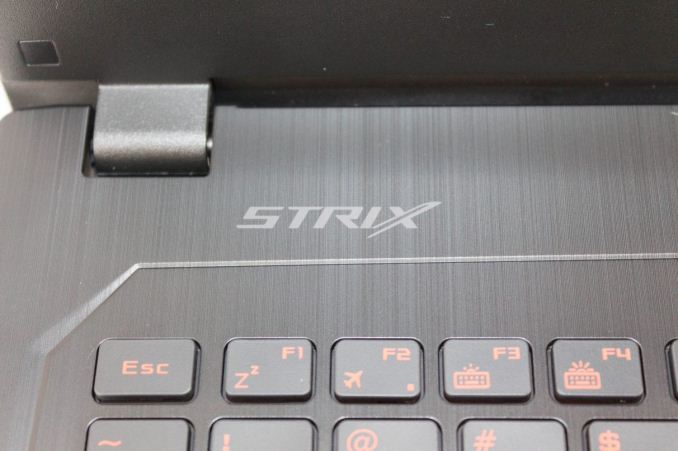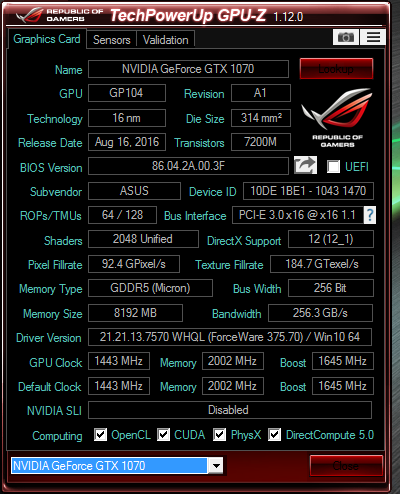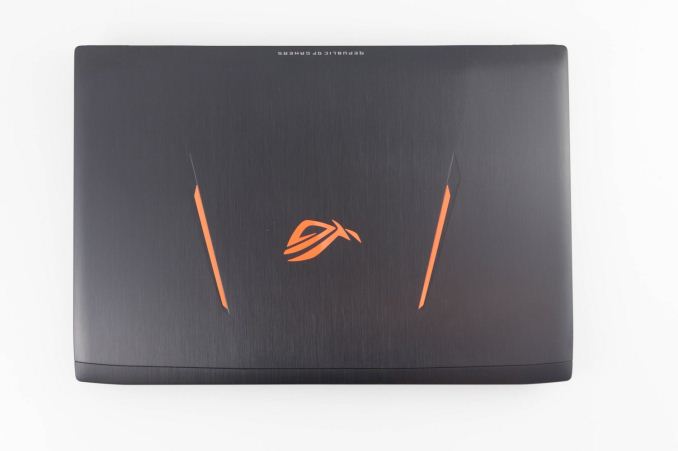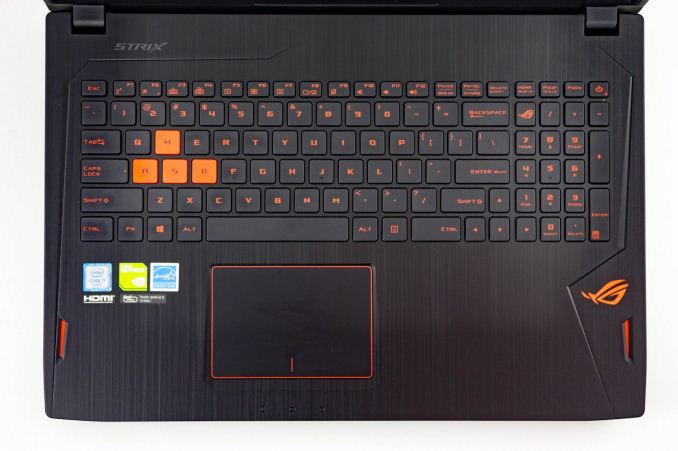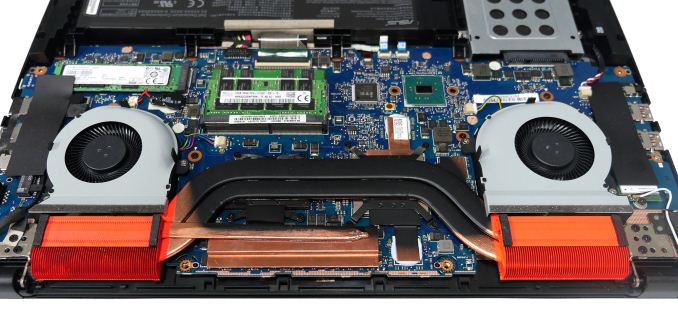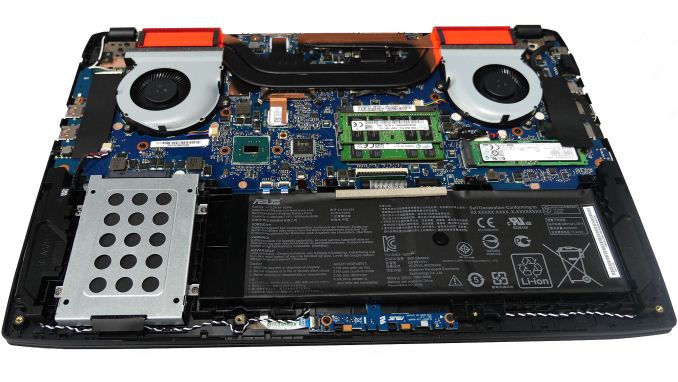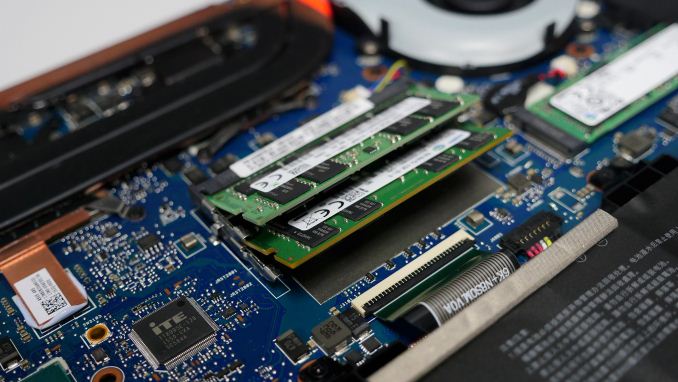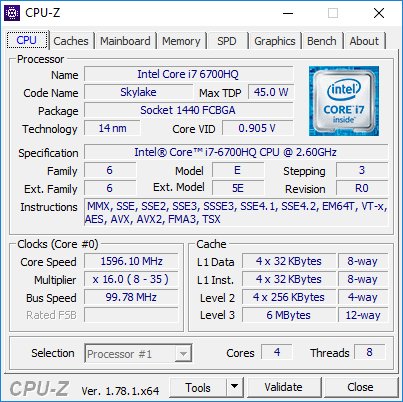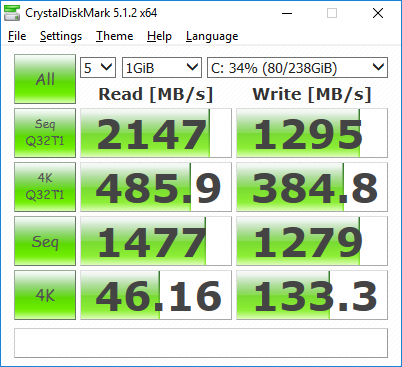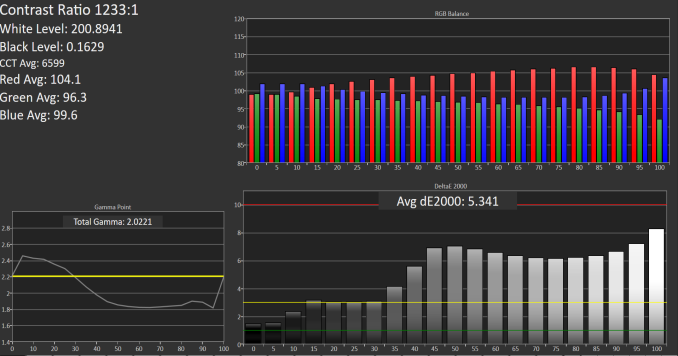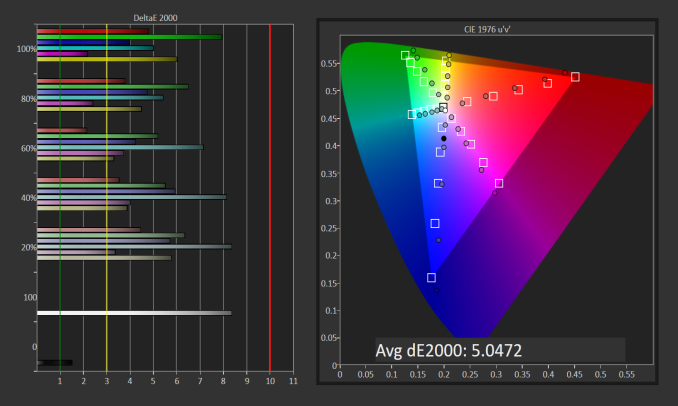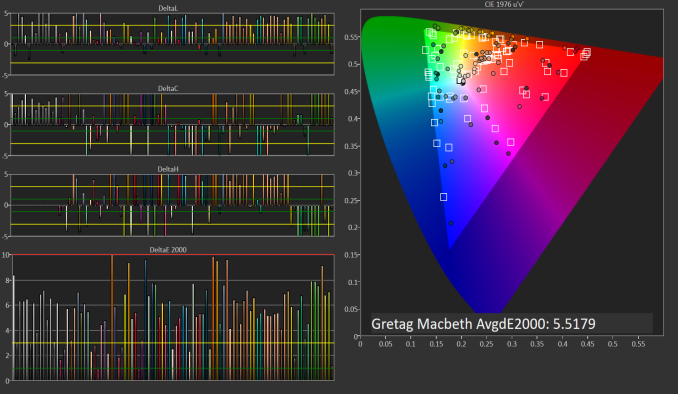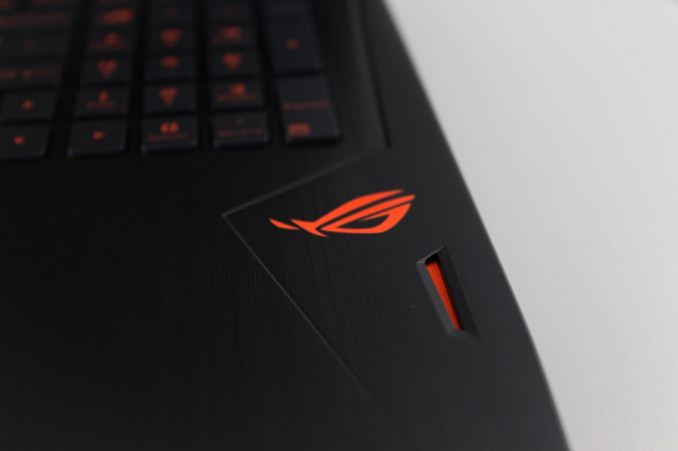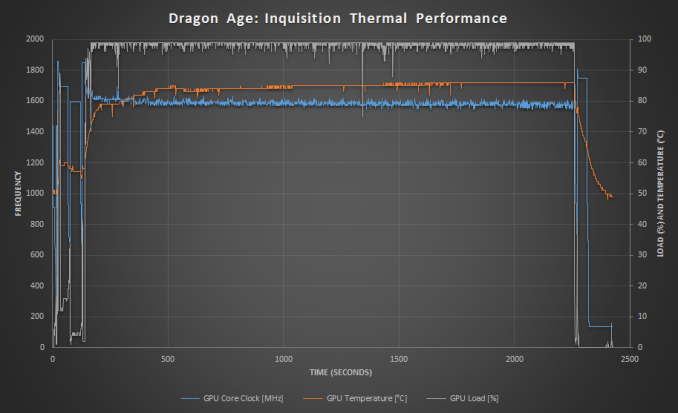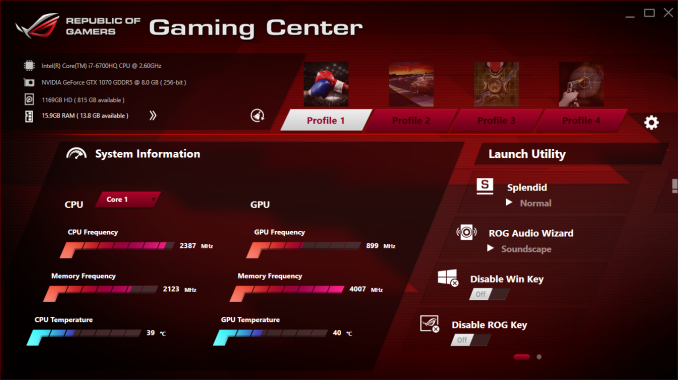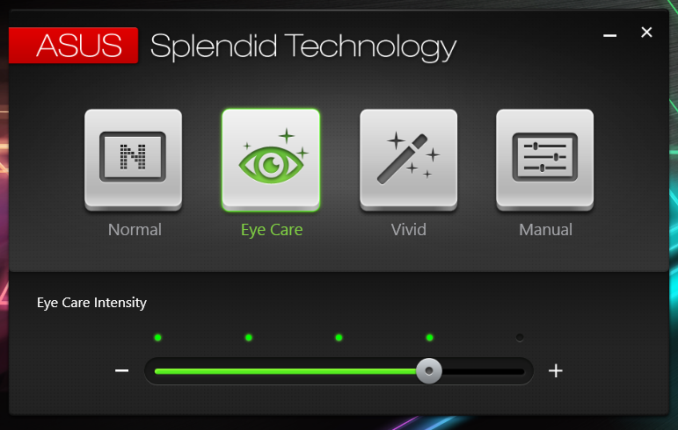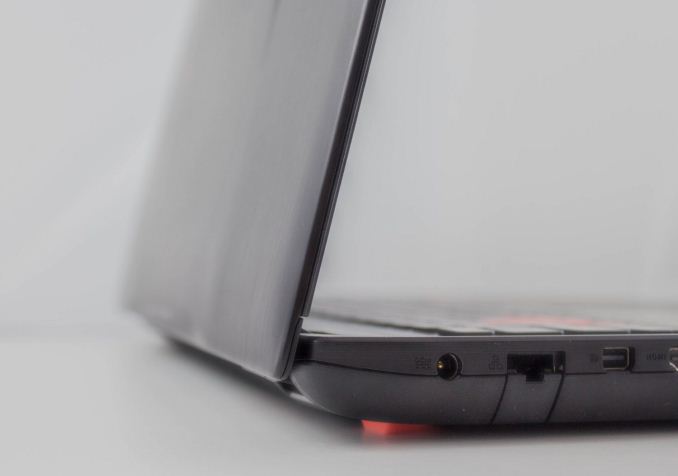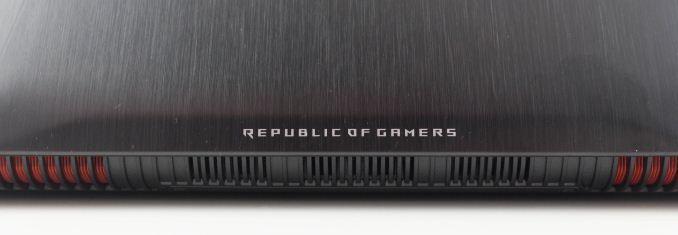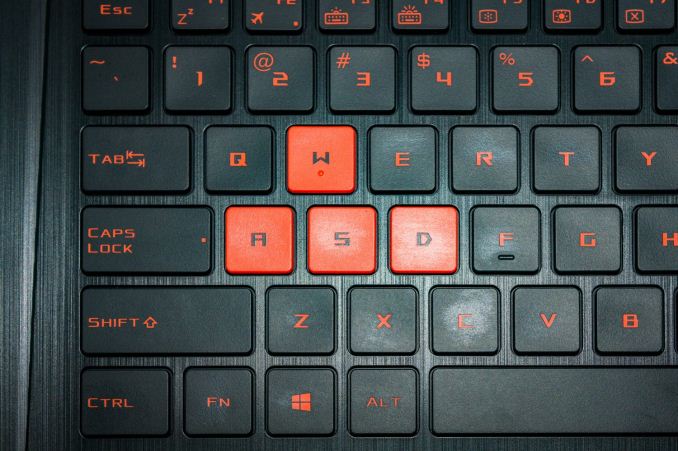
Original Link: https://www.anandtech.com/show/10885/the-asus-rog-strix-gl502vs-review-mainstream-gtx-1070
The ASUS ROG Strix GL502VS Review: Mainstream GTX 1070 with G-SYNC
by Brett Howse on December 9, 2016 8:00 AM EST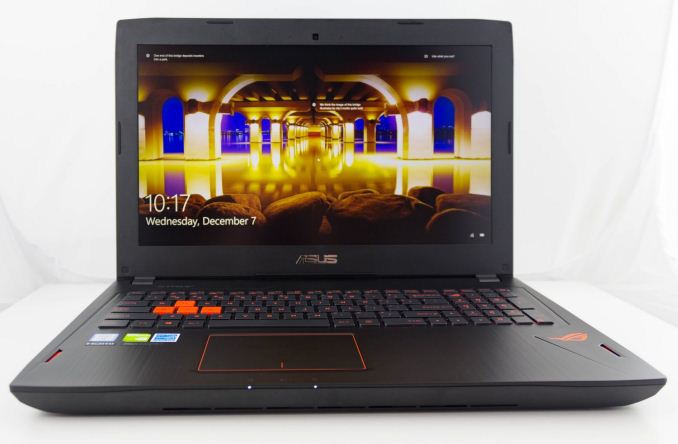
ASUS offers a wide assortment of gaming laptops under “Republic of Gamers”, or 'ROG', with models such as the G752 lineup, the liquid cooled models in the GX800 series, and a few models for those who need more gaming per dollar. Today we are looking at the ASUS ROG Strix GL502VS, which ASUS labels “Compact and Potent”. The Strix branding has morphed a bit over the years, and now tends to signify the more economical products from ASUS, and the GL502VS certainly fits that bill, with quite a bit of hardware packed into a reasonable budget.
There are a couple of models of the GL502, and the VS version here for review is the top end version, featuring an Intel Core i7-6700HQ, NVIDIA GTX 1070, and up to 32 GB of DDR4. There are both 3840x2160 and 1920x1080 displays available, and both feature NVIDIA G-SYNC for a smoother gaming experience. SSDs are available for the boot drive, up to 512 GB, and ASUS also includes a 1 TB 5400 or 7200 rpm HDD for bulk storage to cope with the size of today’s games.
The laptop is fairly compact for a 15.6-inch gaming laptop, with the GL502VS model being 30.1 mm (1.18 inches) thick, and 2.34 kg (5.15 lbs) in weight. But it is not the thinnest or lightest gaming laptop of this size. The lower powered GL502VM model drops the GPU down to a GTX 1060, shaves 7 mm off the height, and 140 grams off the weight.
| ASUS ROG Strix GL502VS | |
| CPU | Intel Core i7-6700HQ 4C/8T 2.6-3.5 GHz 6MB Cache 45W TDP |
| GPU | NVIDIA GTX 1070 4/8GB 2048 CUDA Cores 1442 - 1645 (Boost) MHz |
| Memory | 2 SODIMM Slots, 32 GB Max DDR4 |
| Display | 15.6" 1920x1080 IPS 60 Hz w/G-SYNC Optional 3840x2160 IPS w/G-SYNC |
| Storage | 1 TB 5400/7200rpm HDD Optional 128/256/512GB M.2 SSD, SATA or PCIe |
| I/O | 3 x USB 3.0 Ports 1 x USB 3.1 Gen 2 (Type-C) 1 x HDMI 2.0 output Port (with HDCP) 1 x mini DisplayPort 1.3 output Ports SD Card Slot 1 x Headset Jack 1 x Realtek PCIe GbE RJ-45 LAN (10/100/1000Mbps) |
| Dimensions | 390 x 266 x 30 mm 15.35 x 10.47 x 1.18 inches |
| Weight | 2.34 kg / 5.16 lbs |
| Battery | 62 Wh, 180W AC Adapter |
| Wireless | Intel Dual Band Wireless-AC8260 2x2:2 with Bluetooth 4.1 |
| Price | $1650+ As Tested: 6700HQ, 16GB (1x16) DDR4-2400 , GTX 1070, 256GB SM951 M.2, G-SYNC FHD $1650 USD |
Although I’m not a huge fan of ASUS’s laptop naming schemes, I am a fan of them putting in the latest and greatest technology into their devices. They were very quick out of the gate to transition to SSDs, PCIe SSDs, and USB-C, and that’s the case here as well. The GL502VS features an NVMe Samsung drive, along with a USB 3.1 Gen 2 Type-C port, but they’ve also kept plenty of older I/O as well, including three USB 3.0 ports, mini Display Port, HDMI, RJ45, and a SD card reader.
Wireless is supplied by the Intel Dual Band Wireless-AC 8260 card, which has been a strong performer on all laptops this year. The 62 Wh battery is certainly on the small size for a gaming notebook, but as with most gaming notebooks, they are mostly designed to be plugged into the wall for almost all scenarios, with a battery for the odd time where you need to be a bit more mobile.
The GL502 lineup is quite a bit of performance for not a lot of money, with the GTX 1060 based GL502VM starting around $1300, and the higher performance GTX 1070 based GL502VS starting around $1600.
Design
Without putting too fine a point on it, ASUS can design some stunning notebooks, but this is not one of them. Stepping down to their value line keeps the same powerful internals, but to hit this price point ASUS has taken some liberties with the chassis design. The entire notebook is built from a fairly low quality plastic, with the exception of the lid which has a metal top. The top has a brushed finish with lines running parallel down the entire device, which looks nice, but that’s where the premium materials end.
Opening the notebook, the same brushed finish is replicated on the plastic keyboard deck, but this time on the plastic finish. The keyboard itself features 1.6 mm of travel with red backlighting, but the keyboard feel lacks the nice feel of some of the other ASUS notebooks. The WASD keys are red with black fonts, compared to the rest of the keys which are black with red fonts, and although the look won’t appeal to everyone, it does help quickly identify the most needed keys for gaming. ASUS continues its silly tradition of having the power key right in the keyboard, with it at the top right. If you accidently go to press the minus key, you may end up shutting off the laptop. There’s no good reason for them to put it there, although at least on this notebook, with its extra number pad, it is less likely to get hit than on one of their smaller notebooks where it is right beside the delete key. This seems like a small gripe, but shutting off your computer when going to hit a key is not a great experience.
The trackpad on this notebook does feature the Microsoft Precision Touchpad drivers, for better or for worse, and it’s nice to see Microsoft reigning this in. They still have some work to do with the drivers, but at least it is a consistent experience across devices now. That being said, the trackpad on this notebook is not quite as smooth as some other notebooks, and picks up fingerprints quite readily. It would be nice to see a glass trackpad, although once again the budget comes into play. Luckily a good mouse is going to be required for gaming regardless, so this isn’t as big of an issue as it is on a more portable device.
Being a large gaming laptop, there is expandability with the GL502VS, and just a couple of screws will let you pop off the bottom and access the memory, which has two SODIMM slots, the M.2 SSD, and the SATA drive. Maximum memory is 32 GB through two 16 GB DDR4 modules. On our 16GB sample, only one memory slot was occupied for single channel memory performance.
Interior photos courtesy of rog.asus.com
Overall the design of the ASUS GL502VS is kind of disappointing. The top of the notebook is a very nice looking metal, but the remainder of the notebook is a fairly low grade plastic. ASUS does build some nice notebooks, but to hit their budget on this one with the components on the inside, clearly some cost cutting was necessary. They have also gone a bit overboard with the red accents on this notebook, and especially with the bright shade of red chosen, although the almost orange WASD keys do look nice and red with the keyboard backlighting on.
System Performance
At this point the Skylake mobile quad-core parts are pretty well known. The review unit is outfitted with the Intel Core i7-6700HQ, which is a 45-watt 2.6-3.5 GHz CPU. It has been the staple of almost all quad-core notebooks this year. Also the review unit is outfitted with just a single stick of 16 GB DDR4-2133 memory, which will hamper performance a bit over a dual-channel setup in some of the more varied tests such as PCMark. It’s not quite as critical though on a notebook with a dedicated GPU, but still it would be nice to see 2x8 GB rather than 1x16 GB, unless you wanted to upgrade, in which case the single 16 GB is likely the better choice.
The ASUS GL502VS was put through our standard notebook workflow, which includes a variety of tests to stress different aspects of the device. Several other similar models are used as a comparison, but if anyone wants to compare the GL502VS to any other notebook we’ve tested, please use our online bench.
PCMark
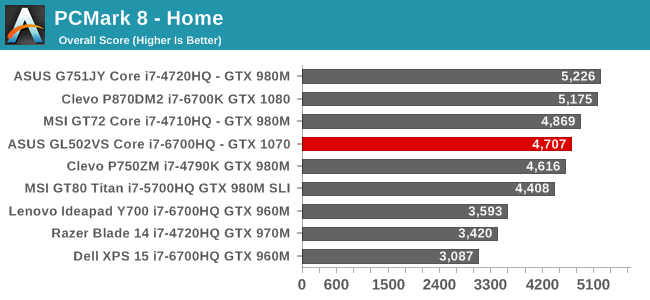
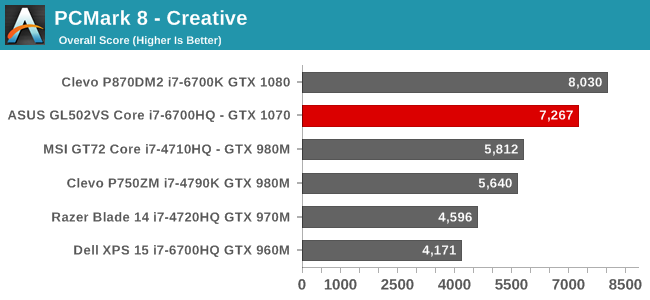
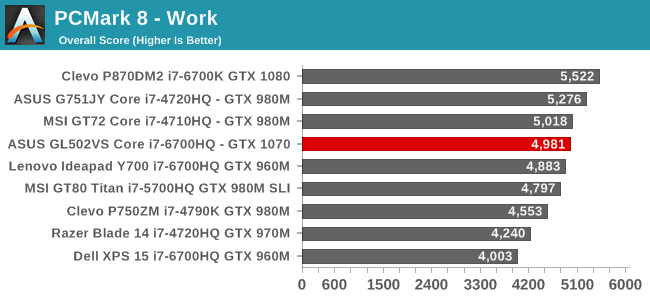
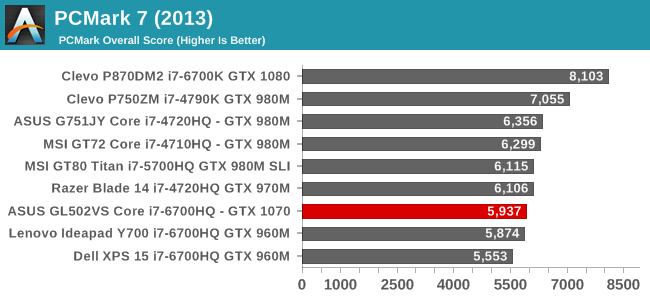
PCMark from FutureMark is a comprehensive system test, which runs through a variety of workloads based on the test chosen. All aspects of the machine impact the final results, including GPU, CPU, memory, drive speed, and even display resolution. The ASUS scores very well here, despite single channel memory performance. The Creative score is quite strong thanks to the much more powerful GPU than previous generation notebooks.
Cinebench
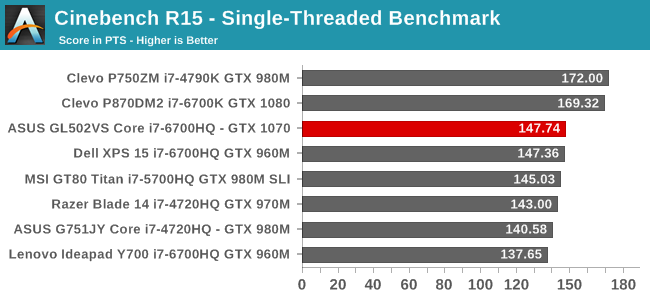
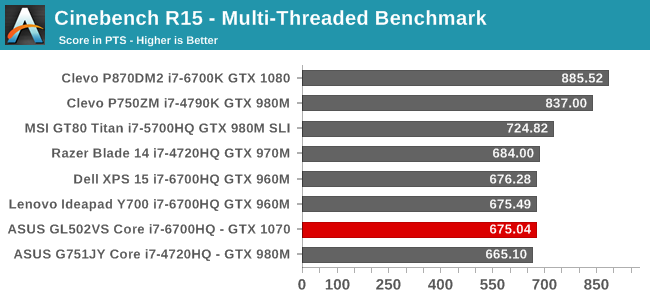
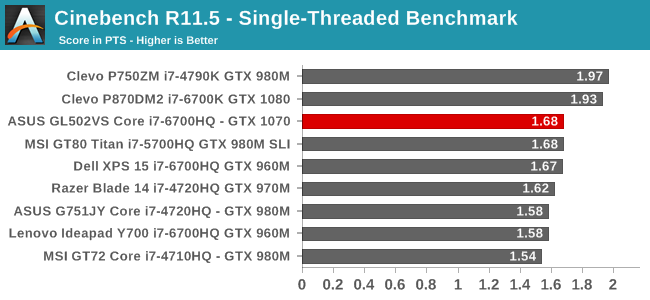
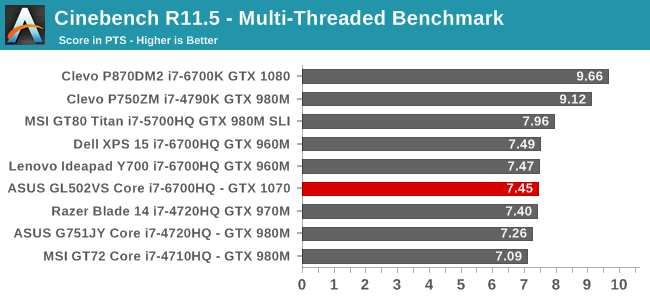
Cinebench is a rendering program which is a pure CPU test. More cores and a higher frequency can pay big dividends on this test. The i7-6700HQ is right in line with other devices with the same CPU.
x264
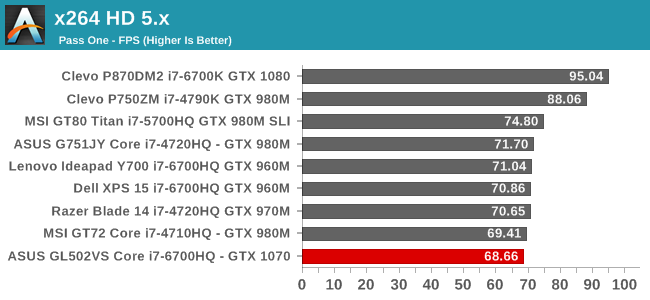
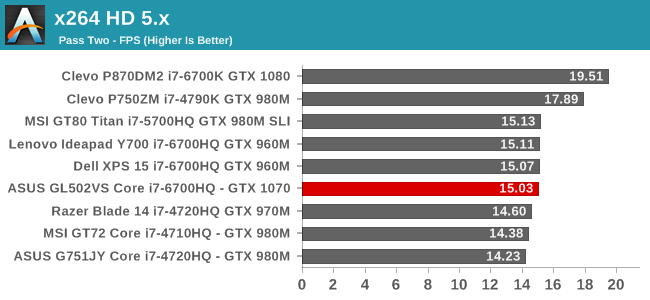
Like Cinebench, this test is mostly a CPU bound test, and once again, the ASUS falls in-line with the other quad-core notebooks featuring this CPU. The desktop class CPUs in the Clevo notebooks have a large advantage on these tests.
Web Tests
The browser is likely the most used application on any computer, and as such browser performance is always important. We’ve moved to Microsoft Edge as the browser with the release of Windows 10, and like Google Chrome and other browsers, the performance of the scripting engine generally improves over time. Each browser performs better on some tasks than others, so these tests have the browser used on each unit pointed out in the results.
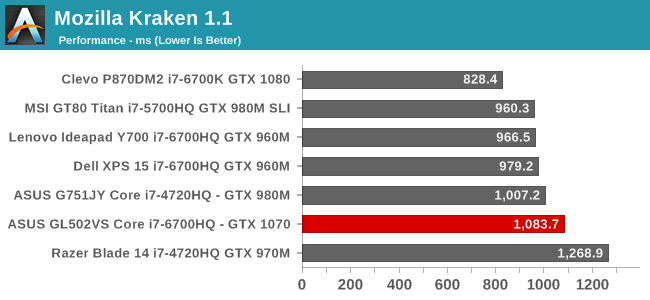
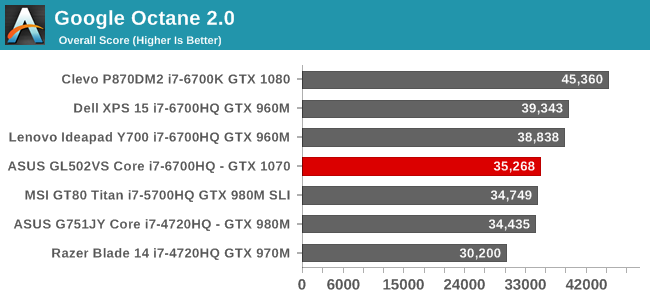
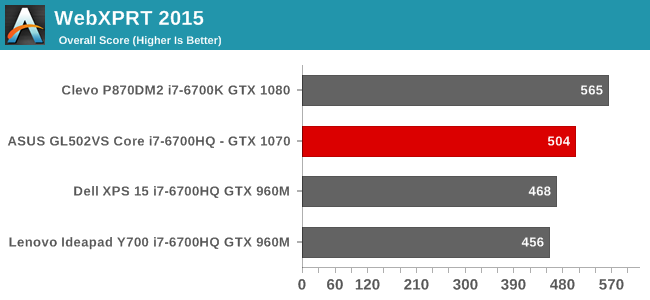
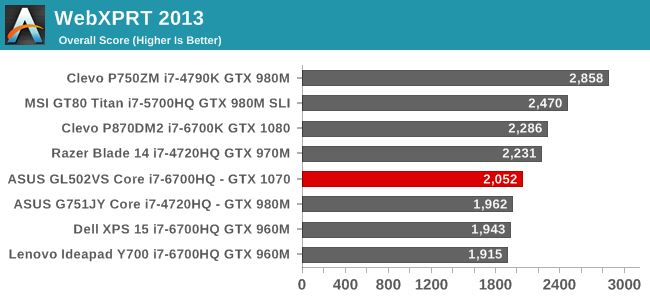
The i7-6700HQ continues to be a strong performer in these tests. The desktop i7-6700K in the Clevo P870DM2 is much quicker, but it’s also a 95-Watt CPU.
Storage Performance
There has been a big push the PCIe based storage over the last twelve months, and ASUS has definitely been at the forefront of that movement. But as we know, not all NVMe drives are the same. NAND capacity is always a factor, and of course TLC or MLC can be a big impact, especially on write speeds where TLC struggles. The ASUS review unit shipped with the Samsung SM951 SSD, which is (unusually for this level of device) an MLC drive. This was already hinted at earlier, but ASUS saved some money on the design of this notebook, but they continue to pack in quality hardware inside, and the use of the SM951 has to be commended since it’s unfortunately very rare to see over the TLC based PM951.
Being just the 256 GB version, the fewer NAND dies compared to the larger capacity models is really the only issue with performance, but it performs very well regardless. Even random read and write speeds are quite strong.
It’s great to see this drive in what would otherwise be considered a budget laptop. Too many laptops, even much more expensive than this one, ship with TLC drives, which are fine, but when you are paying a premium you should expect better.
GPU Performance
The big update with the GL502VS over the previous model is NVIDIA’s new Pascal based GTX 1070, replacing the outgoing GTX 980M on the GL502VY. We’ve gone over this before when the GTX 10-series launched for notebooks, but this is a significant departure from previous mobile GPUs from NVIDIA. We’ve seen this coming over the years, with mobile GPUs and desktop GPUs being based on the same architecture, and the performance delta between them shrinking every year, but with the release of the 10-series, NVIDIA has dropped the M branding for mobile.
This doesn’t mean it’s the same GPU in a notebook as a desktop, but in NVIDIA’s eyes, the performance of the desktop and notebook part are close enough that they feel they can brand them the same. It also makes it easier for the consumer, because a GTX 1070 is a GTX 1070, more or less, when discussing performance, where as the GTX 980M was a pretty big step down from the GTX 980 (which did eventually find its way into high end gaming notebooks near the end of its life). The notebook version of the GTX 1070 is one of the most interesting of the bunch, since it actually has more CUDA cores than the desktop part, at 2048 compared to 1920 on the desktop. The core and boost clock are a bit lower than the desktop part, which means NVIDIA went for a bit of a wide and slow approach to meet their TDP goals, although that is all relative, since it’s far from slow.
The ASUS GL502VS was put through the notebook workload for GPUs, with a couple of new games added as well. To compare it to any other notebook we’ve tested, please use our online bench. First up is some synthetic tests, followed by gaming results.
3DMark
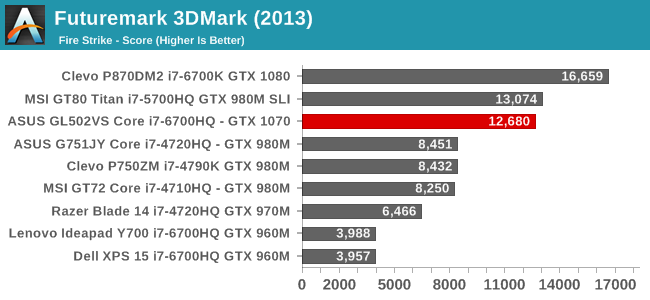
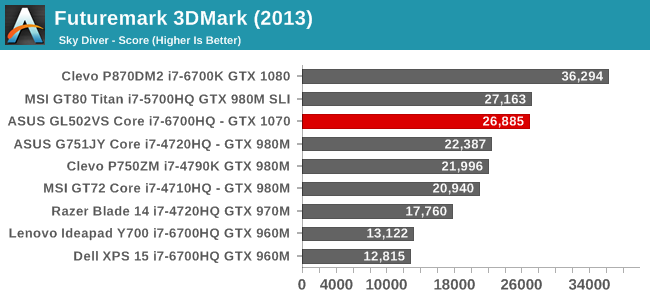
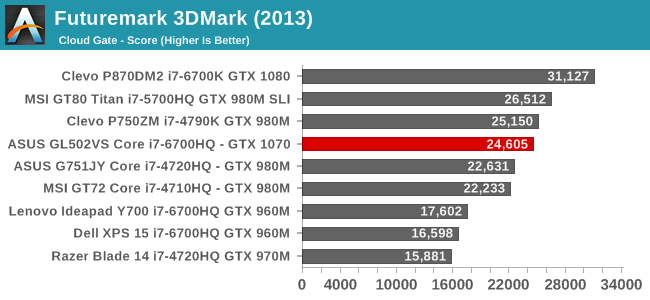
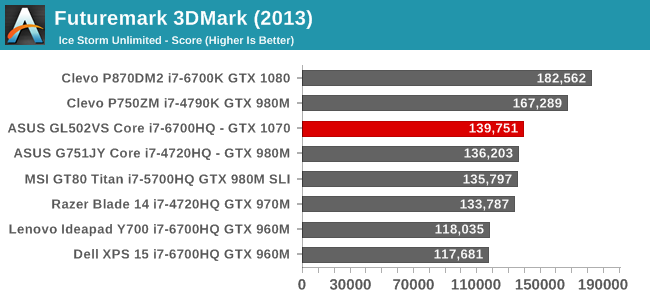
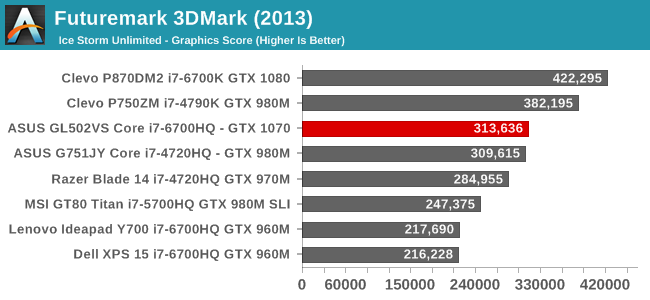
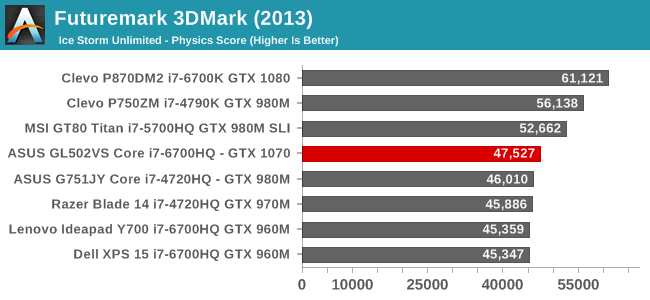
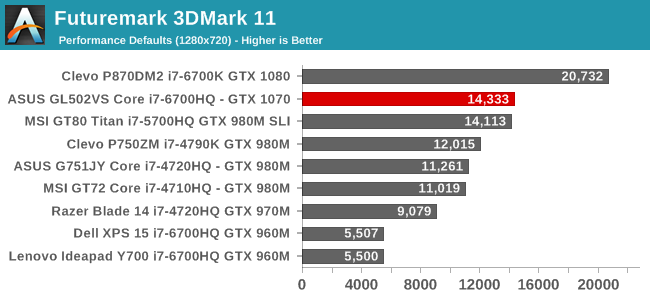
With the more difficult tests of Fire Strike and Sky Diver, the GTX 1070 is within spitting distance of the MSI GT80 Titan with SLI GTX 980M, showing just what a jump in performance the GTX 1070 is. One step under the GTX 1080, and there is still roughly the same performance as the best SLI laptop available with Maxwell. Not a bad start.
GFXBench
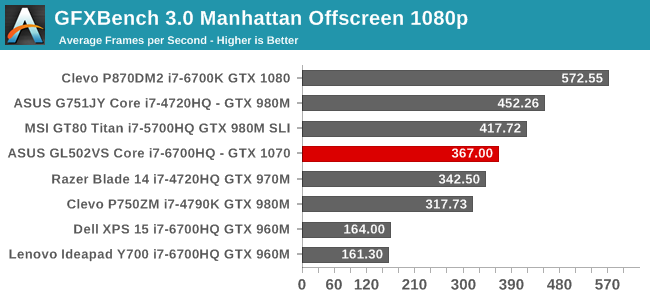
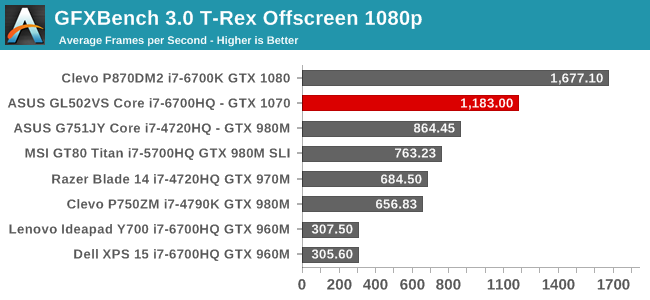
Both of the tests from the older version of GFXBench are really starting to show their age, with scores that are on the far side of ridiculous. The T-Rex scores are kind of insane for both of the Pascal laptops, with results well over 1000 frames per second. The latest version of the test includes some more difficult rendering, and this version will be the new default very soon.
Dota 2 Reborn
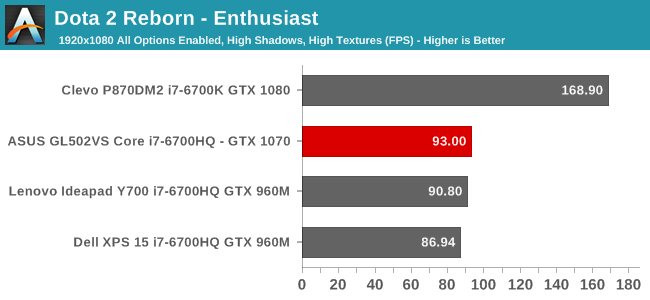
Valve updated the Dota 2 engine quite a while back now, and despite their best efforts, it is still largely a CPU bound test. The GTX 1070 would normally run laps around a GTX 960M, but they are within a couple frames per second of each other with the same CPU available, while the Clevo runs away with this test thanks to the inclusion of a desktop class 95-Watt processor.
Tomb Raider
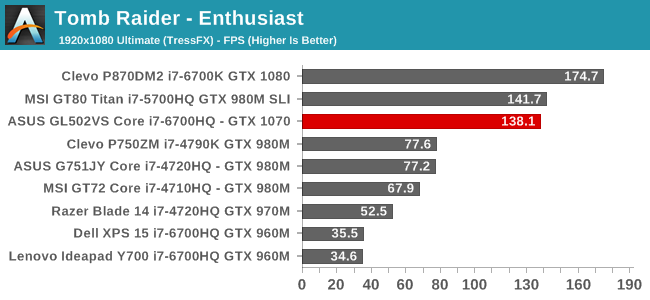
Although several years old, with everything at maximum Tomb Raider can still be punishing to slower graphics processing units, but with the benefits of Pascal and a much more power efficient architecture, the ASUS GL502VS is once again right on the heels of the SLI GTX 980M found in the GT80 Titan. That seems to be a pretty consistent result, which is very impressive for a mid-range GPU.
Rise of the Tomb Raider

The latest version of Tomb Raider is a beautiful game to look at, especially with everything at maximum. The ASUS compares very well here, still averaging almost 100 frames per second. Be warned though, ASUS does offer a version of this laptop with a 4 GB GPU, and you need more than 4 GB of memory to run this game at its maximum settings, so be sure to future proof yourself with an 8 GB model.
Civilization VI



Although the game is new, the underlying engine is pretty much the same, and Civilization continues to be a mostly CPU bound game. Since the last review of the GTX 1080 Clevo, the benchmark has been updated and the scores from that system are no longer valid, so for the time being there is just a single result here, but as you can see there is very little difference between maximum settings and minimum, as far as frame rate. Interestingly they’ve also added a new test to determine the average amount of time between turns, and that should be useful for future reviews as a CPU test.
Bioshock Infinite
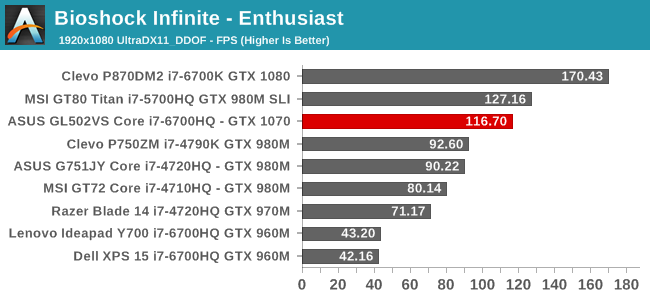
Once again this game is getting a bit old, but it’s still very fun, and can be quite demanding at maximum settings. Pascal is really taking this game for granted though, as even on the maximum settings the frame rate is still very high, and once again it is right behind SLI GTX 980M.
Dragon Age: Inquisition
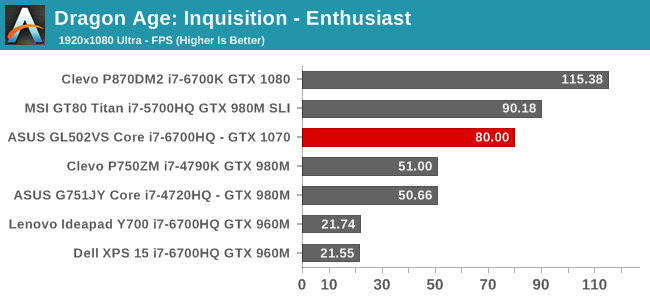
Although behind the GT80 Titan, the ASUS GL502VS is very much right up there when playing this amazing RPG from the end of 2014. There is a healthy step up from the GTX 980M, and the GTX 960M cards aren’t even playable at these settings.
Shadow of Mordor
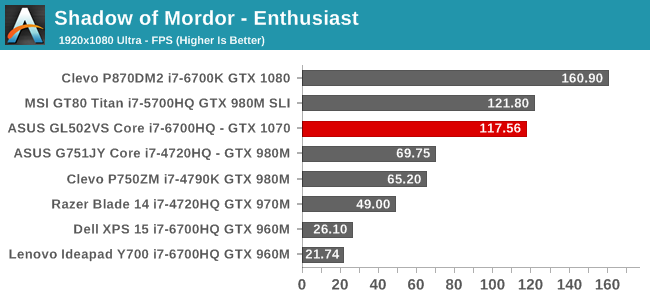
The theme continues, with the GTX 1070 only a hair behind the SLI gaming powerhouse from a year ago.
Grid Autosport
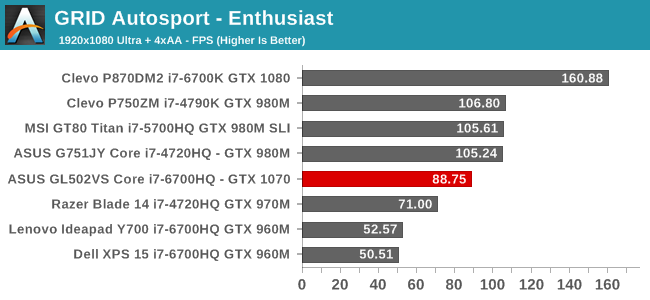
Here we see a bit of a role reversal, with the GTX 1070 falling slightly behind the GTX 980M. This game tends to be CPU bound though, and it’s likely a driver optimization issue here. Regardless, at almost 90 frames per second, it is still not a problem to play.
GPU Conclusion
Maxwell was a big launch for NVIDIA, and the GTX 980M continues to be a pretty powerful GPU, but with FinFET available, Pascal based cards are a huge jump in efficiency. It seems to be pretty consistent in the tests that the GTX 1070 was neck to neck with the SLI GTX 980M, while the GTX 1080 jumps clear of everything by a big margin. The step down to the GTX 1070 from the GTX 1080 is a decent sized step, but regardless the performance of the GTX 1070 is very impressive. Compared to a gaming laptop from a year ago, the ASUS GL502VS is basically on par with the fastest SLI laptops around which is quite an accomplishment.
Most of these games would be playable at UHD resolution (3840x2160) but some of the settings would have to be tweaked for better performance. There isn’t quite enough headroom like on the GTX 1080 to really go for UHD gaming. Just be sure to pick up the 8 GB graphics card to avoid issues in the future, since both a 4 GB and 8 GB model are available.
Display
ASUS offers two displays on the 15.6-inch GL502VS. The standard model is a 1920x1080 FHD version, which is IPS and includes G-SYNC, and that is the panel in the review unit. They also offer a 3840x2160 UHD model, also with G-SYNC. Both displays are the standard 60 Hz refresh rate, but with G-SYNC available the UHD model would be a nice version to try. The display has a matte finish.
The displays cover “72% NTSC” per ASUS, but it would be nice if manufacturers would stop using NTSC as a measurement stick, since it’s not used at all in computing. 72% is sRGB though, which is the standard for computers.
To test the display accuracy, the X-Rite i1DisplayPro colorimeter is used for brightness and contrast readings, and the X-Rite i1Pro2 spectrophotometer is used for accuracy testing. On the software side, SpectraCal CalMAN 5 Business is used with a custom workflow.
Brightness and Contrast
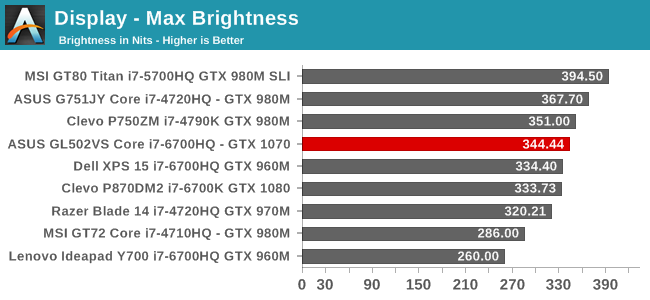
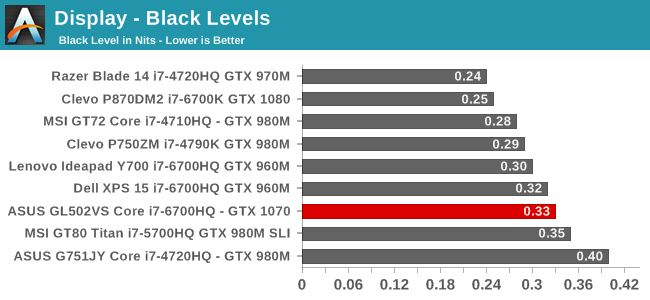
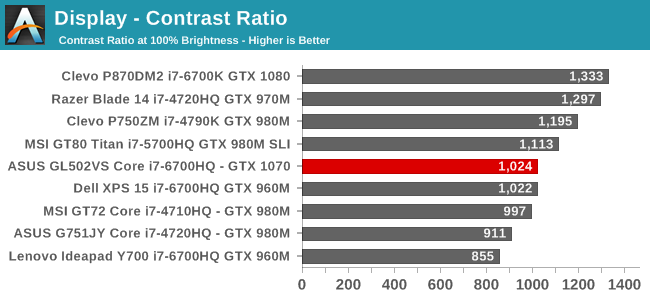
Really high brightness values are most important in very well lit rooms, and the 344 nits output from the ASUS panel is plenty for most situations indoors. However, the black levels are a bit high, so the overall contrast ratio is about mid-pack. 1000:1 is decent for a mid-range laptop though, and it shows just how far laptops have come in the last several years. The minimum brightness is a bit of an issue though, at 38 nits, which is too bright for a very dark room, but for the average laptop on a desk, it shouldn’t be a big issue.
Grayscale Accuracy
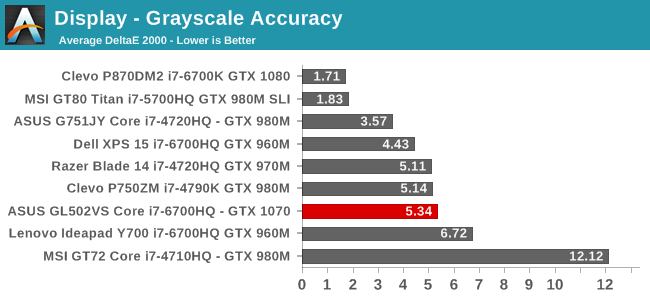
ASUS does not do any sort of display calibration, nor do they ship with an ICC profile, so it has become a bit of an expectation to see they suffer in grayscale. The gamma is very low as well, and despite the CCT Avg being very close to ideal, it just shows how little that number means when you don’t consider all of the primary colors. The reds are far too high, and grayscale errors at 100% white are over 8, which is not ideal. It’s not the worst display around, but it is far from the best. It would be nice to see ASUS do some better calibration, even if it was per batch, to get a handle on their display errors, but they tend to value performance per dollar more, so there is always a trade-off.
Saturation Accuracy
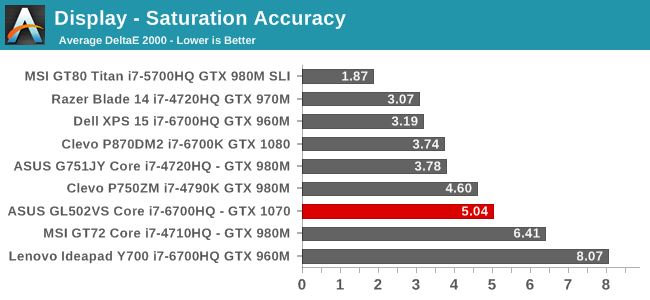
Once again, the lack of calibration does not help the saturation results. Even at just 20% steps, it is very clear that the display is missing its targets. It does not quite cover all of the sRGB space, but it is pretty close, but the blue overshoots and the red falls a bit short. The overall score isn’t helped by the 100% white component which is over 8, but regardless the rest of the color targets have a dE2000 generally over three, and often well over.
Gretag Macbeth
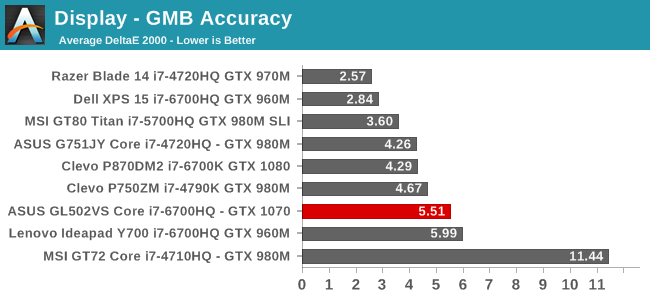
The GMB score is the most comprehensive test, and focuses in on many of the skin tones. The results are not surprising, nor are they very good, with some of the orange, brown, and blue values having error levels approaching 10. The average is much better than practically any laptop from a couple of years ago, but this is a moving target and several of the vendors have focused quite a bit on display quality over the years, and it shows in their results. ASUS still does not factor this in though.
Display Conclusion
Overall the display could use some work, but in the end, it is an IPS display with G-SYNC, so for the gaming market they have the most important boxes checked. It would be great to see ASUS do some work on their displays, but at the same time this would likely add to the bill of materials for the device, possibly increasing prices, and on a value laptop like the GL502VS it is understandable to not see a calibrated display out of the box, but at the end of the day it is still well over $1000, and tablets costing far less do find room in the budget for better results here.
Battery Life
On an Ultrabook, this section is one of the most important, but for a large gaming laptop like the ASUS GL502VS, it is very clear that this is not one of the primary focuses by the engineers. The reason for this is that the laptop has just a 62 Wh battery inside, which is about what you would get in a Dell XPS 13, and less than the Microsoft Surface Book. Some gaming laptops go for the full 99 Wh battery size. For those that are unaware, airline regulations only allow batteries in individual items of less than 100 Wh capacity, so that is the upper limit for now. ASUS has chosen to save a few dollars here and go with a much smaller battery though.
Helping matters is the lower resolution display. 1920x1080 on a 15.6-inch notebook is not high DPI at all, which will help battery life, and Intel’s Skylake lineup of CPUs has gains here too. With NVIDIA now on FinFET as well, there is a chance that the battery life can be decent.
All of our battery testing is done with the device set to 200 nits, and on wireless with the device set the default power setting.
2013 Light Battery Test
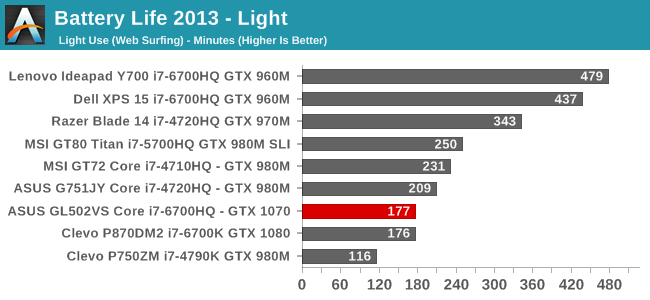
The light test involves just the browser, and opening four web pages per minute. It has become fairly simple for any of the race to sleep processors, and as such it is being phased out, but in order to give a better sample against older machines, the data is still useful.
With just a 62 Wh battery, the ASUS GL502VS ends up very near the bottom, with only the desktop CPU based Clevos below it. It falls just short of three hours on this test.
2016 Battery Life

The 2016 test is a more complex web browsing test, with more realistic page viewing. It in theory should be more taxing on the CPU than the 2013 version.
Interestingly the 2016 test follows the same result as the Clevo, with a score that is slightly higher than the older version of this test. At the end of the day, without having Optimus, the GPU still continues to be a big part of the power draw, masking the results of a bit more CPU work.
Normalized Battery Life
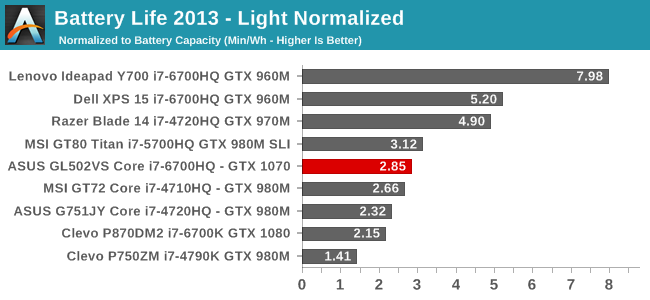

By removing the battery capacity from the equation, you can take a look at the overall platform efficiency. As a true gaming notebook, the ASUS GL502VS lacks NVIDIA’s Optimus technology, meaning the GPU is always running. This impacts battery life quite a bit despite the move to FinFET for Pascal.
You can see that the ASUS would have much better battery life if it just had a bigger battery. Overall efficiency is not too bad, although interestingly it is not quite as good as the SLI GTX 980M GT80 Titan. The laptops that offer Optimus, which are the Lenovo Y700, Dell XPS 15, and Razer Blade, all show a big step up in efficiency with the graphics turned off, and the Lenovo especially but it has a poor display which helps a lot. The 2016 results are a bit sparse at the moment, but will fill in over time with more devices to be tested.
Tesseract Score
Since one of the most obvious ways someone would use a laptop, even one like this, away from the wall socket is to play a movie, it makes sense to test this as well. For this we use the Tesseract score, which is simply how many times could you watch The Avengers, which is 143 minutes long.


The ASUS will get through one running of The Avengers, but if you decide to watch it another time, or just another movie, you are going to need somewhere to plug in.
Charge Time
Although the ASUS is generally going to be sitting on a desk plugged into power, there will be times where the laptop needs to be used away from the desk for a bit. Charge time can be important, especially when the overall battery life is not great.
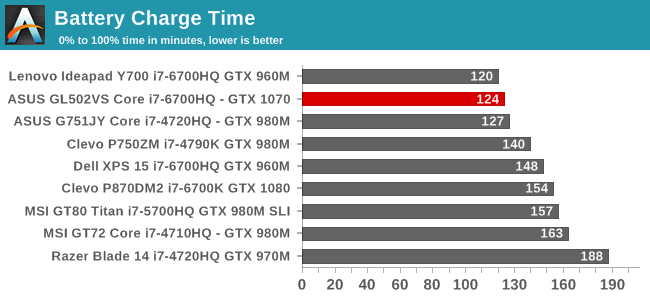
The charge time for the ASUS is right near the top, which makes a lot of sense considering it has a much smaller than average battery to refill, but still has a hefty 180-Watt AC Adapter powering it.
Wireless
ASUS outfitted the GL502VS with the Intel Dual Band Wireless-AC 8260 network adapter, and it has been in quite a few notebooks this year. This is easily Intel’s best network adapter yet, combining solid connections with impressive speed. They have an 8265 model which we should be seeing soon, adding the MU-MIMO features they have been missing on previous cards.
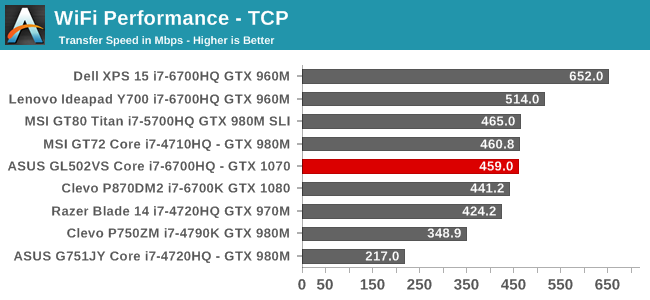
The ASUS implementation is very solid, offering transfer rates that can peak well over 600 Mbps, and sustained transfer rates are quite good as well. It doesn’t quite match the 3x3 solution that Dell offers on the XPS 15, but for a 2x2:2 adapter it is easily one of the best out there.
Audio
ASUS has two speakers which fire up towards the user. There are small red speaker grills on the keyboard deck which fit in well with the overall theme of the notebook design.
The speakers get reasonably loud, with measurements of 83 dB(A) while playing back a music track with the SPL meter one inch over the trackpad. The sound quality is not great though, with the typical flat sound of a notebook that struggles to reproduce much of the audible range. As with most notebooks, headphones would be a wise choice, especially with the fan noise.
Thermals
Keeping everything cool in a gaming laptop is clearly a “must have” on anyone’s list. Unlike some burst workloads, gaming sessions can easily span hours. ASUS uses a dual-fan solution which has copper and heat pipes to help move the heat away from the GPU and over to the fans. One design choice which gets in the way slightly though is the display hinge, which causes the bottom of the display to swing behind and cover some of the vent.
Running Dragon Age at maximum settings for an extended period of time shows that the thermal solution is adequate in that the GPU does not thermally throttle under its base clock. In the test, the temperature peaked at 86°C, and the GPU was able to manage about 1550 Mhz.
The chassis did get very warm though, thanks to the display hinge design. With some of the hot exhaust air being blocked, and redirected forward, the top of the laptop got very warm, with an average of around 50°C above the keyboard, with some sections closer to 55°. ASUS is certainly not the only company to do this, but a hinge-forward design like they use on the ASUS G752 would really help here.
The fan noise was high as well, especially under sustained load where it was measuring 51 dB(A) with the SPL meter an inch over the trackpad. This is quite loud and would necessitate headphones for most gaming scenarios. At idle, the fans do run all the time, with a constant 40 dB(A) measured in the same location. The fan pitch is low enough where it is not distracting, but it is certainly audible.
Software
ASUS has a couple of utilities included, with the main one being the ROG Gaming Center. This utility allows you to quickly and easily monitor CPU and GPU frequency and temperature, and adjust things such as disabling the Windows Key.
There are several profiles which you can set up as you like, and the switch to them later to quickly set the laptop to a baseline for a particular task.
The software is pretty simple to use, and effective enough. What it is missing though is the ability to bind macros to the keyboard, which is something that some gamers do use, and it would be nice to see this as an option.
The ROG Gaming Center can also be used to launch into other utilities, such as the ASUS Splendid utility, which is a tool they bring to adjust the display. There are four modes, with normal, vivid, and custom as the typical ones, with custom allowing you to change the display color temperature. The fourth is their Eye Care mode, which eliminates the blue levels, and the amount can be adjusted with a simple slider.
Overall the ASUS GL502VS is fairly light on software, which is a good thing. There is the basic utilities, an install of XSplit Gamecaster, and not much else, which is a welcome change from many devices.
Final Words
ASUS has built a powerful gaming system, with all the latest technology inside. The Core i7-6700HQ is well known, and very capable. There will likely be a Kaby Lake update for quad-core processors soon, and we’ll see how they compare, but for now this is a capable CPU for a portable computer. The NVIDIA GTX 1070 is a very large step up from the GTX 970M, with performance that is right in-line with two GTX 980M cards in SLI. We’ve been waiting for FinFET for years on the GPU side, and it has paid off. In addition, it has up to 8 GB of GDDR5, and if you are interested in this notebook be very sure you are getting the 8 GB model since games like Rise of the Tomb Raider already use more the 4 GB on maximum settings.
As seems to be the case with ASUS, they also make sure the rest of the system is up to par as well. The single channel RAM is unfortunate, but also a bonus if you want to add another 16 GB yourself, since you’d only need to buy one more SO-DIMM. There is also USB 3.1 Gen 2, offering up to 10 Gbps of bandwidth, although it doesn’t support Thunderbolt 3. There are three USB 3 ports as well, meaning you have one foot in the present and one in the future. Gigabit Ethernet is pretty much expected on a gaming notebook, and it’s not missing either, but the Intel 8260 wireless adapter is one of the best we’ve ever used, offering great connection and transfer speeds, and a trouble-free experience. For those that need to connect to an external display, ASUS offers both HDMI and mini Display Port as well.
The included 62 Wh battery is pretty small for a system of this size, and that impacts the battery life quite a bit. The battery life on any gaming notebook is generally not very good though, and you pretty much need to use this on a desk plugged into a wall if you are going to use it for any length of time.
For a notebook of this size and power, the fact that ASUS got it under five pounds is a nice touch too. If you look around at the competition, something like the MSI GT62VR with GTX 1070 is about 6.5 pounds, and that is a big difference if you do need to travel with it.
The build quality is just average though, and the materials are decidedly low-end. There is nothing wrong with a plastic for a notebook body, but there are definitely different grades of plastic, and the one chosen for the GL502VS is very low quality. The keyboard is middle of the road, and while it is backlit, it only offers red backlighting when much of the competition offers choice here. The trackpad is not something I would want to use daily, so a mouse is almost a necessity. Some attention to detail here would go a long way, since this is the main part of the notebook experience. ASUS can do better, because they do offer better options on some of their other notebooks.
The cooling solution seems to get the job done, but once again ASUS has done better in other notebooks. The cooling vents blow directly onto the display when it is open, which causes the laptop to get quite warm, especially around the hinge where it is as high as 55°C. ASUS has a hinge-forward design on the G752 to avoid this exact issue, but it is not leveraged here. At the end of the day, it can keep the GTX 1070 cool enough to avoid throttling, but only just.
Despite the less than amazing chassis, the ASUS ROG Strix GL502VS does offer a competitive value for what is offered. The pricing is reasonable for a powerful gaming laptop, starting around $1275 for the GTX 1060 GL502VM with no SSD. The GTX 1070 GL502VS is closer to $1650 at the moment though, which starts to put it very close to some of the competition, or even above something like the MSI GT62VR depending on sales. Gigabyte also offers the P35Xv6 in this size, but for a bit more money. If you are in the market for a 15.6-inch gaming notebook, the space is very competitive. ASUS needs to address some of the build quality to really stand out in this space.

